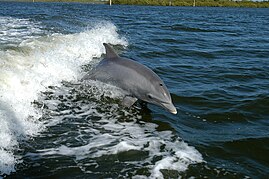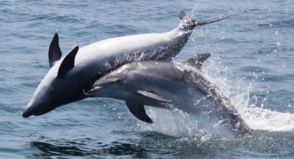
A signature whistle is a learned, individually distinctive whistle type in a bottlenose dolphin's (Tursiops truncatus) acoustic repertoire that gives the identity of the whistle owner. The whistles are identified and studied in the wild or in captivity by researchers using hydrophones. Vocal learning strongly influences the development of signature whistles, which can remain stable for up to at least 12 years. More often than not, calves develop signature whistles by the sounds they hear while making sure that they differ from close associates. However, male calves tend to learn signature whistles that resemble their mother's. They are believed to be most frequently used in the communication of captive bottlenose dolphins, along with having specialized functions and properties. Signature whistles are in a higher frequency range than humans can hear. Researchers define a signature whistle as a whistle with a unique frequency curve that dominates in the repertoire of a dolphin. Each dolphin has a distinct signature whistle that other members of its social group use to individually identify the whistler. They are typically used for localisation purposes, however they also provide dolphins with behavioural context. Signature whistles have an important role in facilitating mother–calf contact, group cohesion and social interaction.
Identification
Identification of signature whistle calls from wild, unrestrained bottlenose dolphins is essential to understand how they are used in their natural environment. Signature whistles of bottlenose dolphins can be recorded in the wild or in captivity. Hydrophones are used in both cases, but the number of devices may vary based on the researcher's preference and methodology. Using multiple hydrophones allows the researchers to better identify which dolphin emitted which whistle. Although multiple hydrophones are used, signature identification uses a single hydrophone and allows better identification. Variation between signature whistles can be tested by examining the whistle contours frequency modulation pattern. A frequency modulation pattern differs between dolphins, which is usually identified by using standard acoustic parameter measurements, such as beginning, end, maximum or minimum frequency. Combining the measurements of the frequencies will show the modulation pattern of the individuals signature whistle.
Signature whistles are difficult to identify because bottlenose dolphins emit non-signature whistles as well. However, there is a distinct amount of time in between each signature whistle that helps researchers distinguish them from the rest of dolphin noises. Signature whistles are typically emitted within 1 to 10 seconds of each other, while non-signature whistles can occur with longer or shorter intervals between each whistle. This distinction can be used to identify signature whistles in hydrophone recordings.
An early definition of signature whistles defined them as the most common whistle emitted when a dolphin is kept in isolation. This description restricted research designs to only studying dolphins in captivity. The current method for identifying signature whistles is known as signature identification, or SIGID. Developed by Janik and King, this method combines human observations with vocalization analysis. The vocalizations are recorded by a single hydrophone. This method allows researchers to better identify signature whistles when studying wild dolphins because it can be used in situations where many dolphins emit whistles at the same time.
Development
A dolphin's signature whistle development is influenced by auditory experience, and usually fully develops within the first year of life, rarely changing throughout adulthood. Stable whistle call structure for at least a decade is necessary for long term call recognition between bottlenose dolphins. A calf develops its own signature whistle based on the sounds they hear and most calves develop signature whistles that differ from their close associates. Calves tend to model their signature whistles after those of adult dolphins who they do not spend much time with. Due to the fact that signature whistles are unique, a calf's signature whistle never matches a single whistle but instead has similarities to multiple whistles. However, male calves tend to develop signature whistles that resemble the signature whistles of their mother's. The male calf does not copy the whistle, instead it uses it as a model.
Vocal learning is essential in a dolphin calf's signature whistle development. It plays an important role in development because it helps to build an individualized whistle with a unique frequency modulation pattern. It is an animal's ability to imitate vocalizations from other animals of the same species, and eventually produces its own sounds. Social interaction plays a significant role in vocal learning. Although vocal learning is often associated with aggressive behavior in some animals, this is not the case in dolphins. Rather, vocal learning strengthens social bonds, such as those between mother-calf pairs and alliance partners.
Apart from signature whistles being developed socially there are other behavioural, ecological, genetic and modification factors that can also influence the development of a dolphin's whistle. For example, signature whistles may vary from a behavioural factor and the temporal production of whistles can be affected by stress or other psychological influences. Determining the contribution of different influences on signature whistle variation, aside from social influence, is difficult to achieve due to minimal populations. It is best examined in multiple populations using recordings collected from various behavioural contexts.
Group interaction
Within groups

Signature whistles are primarily used to locate group members, however they can also provide dolphins with the behavioural situations their group members are in. Dolphins primarily emit signature whistles when one individual is separated from the rest of the group. Non-signature whistles are the main vocalization when all of the group members are together. Although signature whistles are used to locate other dolphins, captive dolphins, who can use their sight to locate other animals, also emit these whistles. It is believed that signature whistles contain information other than location or identity, and can explain why dolphins in captivity use them. Signature whistle emissions also increase during socialization and predation.
Similar to vocal learning, bottlenose dolphins demonstrate vocal copying. Bottlenose dolphins repeat another dolphin's signature whistle back in order to address that particular dolphin individually. Unlike other animals, dolphins do not display this behavior in aggressive situations. Humans and dolphins are the only known species to use vocal copying in cooperative contexts. Although this behavior is rare, dolphins with close relationships are more likely to demonstrate vocal copying. Also, bottlenose dolphins are capable of producing almost perfect copies of another dolphin's whistle. Any differences in the repeated whistle could be deliberate, reinforcing the idea that the dolphins individually address close relatives.
Child–directed communication
In the Sarasota Dolphin Research Program's library of recordings were 19 female common bottlenose dolphins producing signature whistles both with and without the presence of their dependent calf. In all 19 cases, the mother dolphin inflected the signature whistle when their calf was present, by reaching a higher frequency, or using a wider frequency range. Similarly, humans use higher fundamental frequencies and a wider pitch range to inflect child–directed speech (CDS). This has rarely been discovered in other species. The researchers stated that CDS benefits for humans are cueing the child to pay attention, long-term bonding, and promoting the development of lifelong vocal learning, with parallels in these bottlenose dolphins in an example of convergent evolution.
Between groups
Dolphins also use signature whistles to provide identity information when meeting new groups of dolphins. When groups of dolphins first join whistle exchanges are a necessary component of the social interaction. Signature whistles between groups are the primary source in providing identity information due to the fact that only 10 percent of joins occurred without whistles. Signature whistle emission rates are nine times higher when two groups encounter each other than in peak whistle rates during general socialization within pods; and they repeat them multiple times during the exchange. The repetition of signature whistle's increases the chances of correct identification.
Whistle matching may occur when two or more groups of dolphins encounter each other, as well. Bottlenose dolphins have low rates of aggression towards close associates and other members of the species. It is observed when a dolphin copies another individual's whistle and repeats it back. Matching occurs in order for one dolphin to acknowledge another individual's presence, which can occur when the animals are up to 600 meters apart. Signature whistles may play an important role in interactions between groups.
References
- ^ Kriesell HJ, Elwen SH, Nastasi A, Gridley T (2014-09-09). "Identification and characteristics of signature whistles in wild bottlenose dolphins (Tursiops truncatus) from Namibia". PLOS ONE. 9 (9): e106317. Bibcode:2014PLoSO...9j6317K. doi:10.1371/journal.pone.0106317. PMC 4159226. PMID 25203814.
- ^ Janik V, King S (2013). "Identifying signature whistles from recordings of groups of unrestrained bottlenose dolphins (Tursiops truncatus)". Marine Mammal Science. 29: 109–122. doi:10.1111/j.1748-7692.2011.00549.x. hdl:1912/5917.
- ^ Janik VM, Sayigh LS, Wells RS (May 2006). "Signature whistle shape conveys identity information to bottlenose dolphins". Proceedings of the National Academy of Sciences of the United States of America. 103 (21): 8293–7. Bibcode:2006PNAS..103.8293J. doi:10.1073/pnas.0509918103. PMC 1472465. PMID 16698937.
- ^ Janik VM, Todt D, Dehnhardt G (1994-10-01). "Signature whistle variations in a bottlenosed dolphin, Tursiops truncatus". Behavioral Ecology and Sociobiology. 35 (4): 243–248. doi:10.1007/BF00170704. ISSN 1432-0762. S2CID 38219136.
- Janik V (2009). Acoustic communication in delphinids. Vol. 40. pp. 123–157. doi:10.1016/S0065-3454(09)40004-4. ISBN 9780123744753.
{{cite book}}:|journal=ignored (help) - ^ "Motherese in bottlenose dolphins". Proceedings of the National Academy of Sciences of the United States of America. September 25, 2023. Retrieved December 26, 2023.
- ^ Agafonov A, Panova E (2012). "Individual patterns of tonal (whistling) signals of bottlenose dolphins (Tursiops truncates) kept in relative isolation". Zoology. 39 (5): 430–440. doi:10.1134/S1062359012050020. S2CID 15098556.
- ^ Lopez B (2011). "Whistle characteristics in free-ranging bottlenose dolphins in the Mediterranean Sea: influence of behavior". Mammalian Biology. 76 (2): 180–189. doi:10.1016/j.mambio.2010.06.006.
- ^ Janik VM (August 2000). "Whistle matching in wild bottlenose dolphins (Tursiops truncatus)". Science. 289 (5483): 1355–7. Bibcode:2000Sci...289.1355J. doi:10.1126/science.289.5483.1355. PMID 10958783. S2CID 12617292.
- ^ Fripp D, Owen C, Quintana-Rizzo E, Shapiro A, Buckstaff K, Jankowski K, et al. (January 2005). "Bottlenose dolphin (Tursiops truncatus) calves appear to model their signature whistles on the signature whistles of community members". Animal Cognition. 8 (1): 17–26. doi:10.1007/s10071-004-0225-z. PMID 15221637. S2CID 23249079.
- ^ King SL, Sayigh LS, Wells RS, Fellner W, Janik VM (April 2013). "Vocal copying of individually distinctive signature whistles in bottlenose dolphins". Proceedings. Biological Sciences. 280 (1757): 20130053. doi:10.1098/rspb.2013.0053. PMC 3619487. PMID 23427174.
- Nottebohm F (1972). "The origins of vocal learning". The American Naturalist. 106 (947): 116–140. doi:10.1086/282756. S2CID 83505016.
- ^ Sayigh, Laela S.; El Haddad, Nicole; Tyack, Peter L.; Janik, Vincent M.; Wells, Randall S.; Jensen, Frants H. (4 July 2023). "Bottlenose dolphin mothers modify signature whistles in the presence of their own calves". Proceedings of the National Academy of Sciences. 120 (27). National Academy of Sciences: e2300262120. doi:10.1073/pnas.2300262120. hdl:10023/27844. PMC 10318978. PMID 37364108.
- Gleason, Jean Berko., and Nan Bernstein Ratner. "The Development of Language", 8th ed. Pearson, 2013.
- ^ Quick NJ, Janik VM (July 2012). "Bottlenose dolphins exchange signature whistles when meeting at sea". Proceedings. Biological Sciences. 279 (1738): 2539–45. doi:10.1098/rspb.2011.2537. PMC 3350692. PMID 22378804.